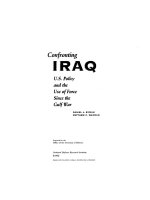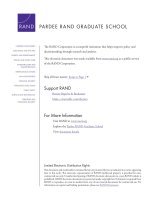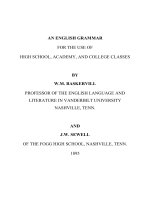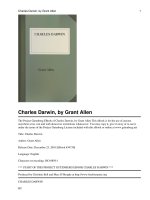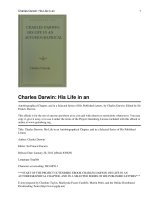- Trang chủ >>
- THPT Quốc Gia >>
- Hóa
The use of machines
Bạn đang xem bản rút gọn của tài liệu. Xem và tải ngay bản đầy đủ của tài liệu tại đây (3.24 MB, 10 trang )
Genre
Nonfiction
Comprehension Skill
Cause and Effect
Text Features
•
•
•
•
Captions
Charts
Diagrams
Glossary
Science Content
Simple Machines
Scott Foresman Science 6.16
ISBN 0-328-14016-3
ì<(sk$m)=beabgj< +^-Ä-U-Ä-U
Vocabulary
compound machines
effort force
fulcrum
load
machine
simple machine
work
Picture Credits
Every effort has been made to secure permission and provide appropriate credit for photographic material.
The publisher deeply regrets any omission and pledges to correct errors called to its attention in subsequent editions.
Photo locators denoted as follows: Top (T), Center (C), Bottom (B), Left (L), Right (R), Background (Bkgd).
5 Jeffrey Greenberg /Photo Researchers, Inc.; 6 ©The Science Museum, London /DK Images; 8 Felicia Martinez/
PhotoEdit; 10 (T) ©Conrad Zobel/Corbis. (BL) Brian Mitchell/Alamy Images; 12 Brand X Pictures; 15 (BR) ©The Science
Museum, London /DK Images.
Scott Foresman/Dorling Kindersley would also like to thank: 11 (BL) Stephen Oliver/DK Images.
Unless otherwise acknowledged, all photographs are the copyright © of Dorling Kindersley, a division of Pearson.
ISBN: 0-328-14016-3
Copyright © Pearson Education, Inc. All Rights Reserved. Printed in the United States of America.
This publication is protected by Copyright, and permission should be obtained from the publisher prior to any
prohibited reproduction, storage in a retrieval system, or transmission in any form by any means, electronic,
mechanical, photocopying, recording, or likewise. For information regarding permission(s), write to
Permissions Department, Scott Foresman, 1900 East Lake Avenue, Glenview, Illinois 60025.
3 4 5 6 7 8 9 10 V010 13 12 11 10 09 08 07 06 05
What did you learn?
1. What is the scientific definition of work?
2. What type of simple machine is the Ferris wheel?
3. What are some examples of the simple machine
called the wedge?
4.
All machines help people
do work. Write to explain the difference
between simple machines and compound
by L.from
L. Owens
machines. Include details
the book to
support your answer.
5.
Cause and Effect What would be the effect
of friction when moving a heavy object, such as
a piano, over wheels, as opposed to moving it
without wheels?
Work and Machines
Defining Work
What do you think about when you hear the word work?
Do you think of chores you do around the house, such as
taking out the garbage, setting the table for dinner, or making
your bed? Do you think of different jobs that adults have,
such as truck driver, computer programmer, or nurse?
All of these examples fit the meaning of work
as we use it in our daily lives. We’re going to
take a closer look at another way to think
about work.
In science, work is the use of force
to move something a certain distance.
The force—or pushing and pulling—
is applied to an object. You can tell
that work has occurred when an
object moves. If the object doesn’t
move, no work has occurred.
If you use a wheelbarrow to
move a heavy load across your yard,
you have done work. Work was done
because the load moved. Suppose you
tried to lift the load out of the wheelbarrow
but it was too heavy. No matter how hard
you push or pull, you cannot move the load.
In this case, you have not done work because
the load did not move.
When you lift and push a
wheelbarrow, work is occurring.
2
Work Can Be Measured
You can find out how much work is done for
a given task. All you need is to know the formula
that scientists use to measure work:
work = force x distance
Work is measured in a unit called the joule.
The abbreviation for the joule is J.
1 joule (J) = 1 newton (N) x 1 meter (m)
Let’s use the formula to measure some
work. You moved a wheelbarrow a distance
of 20 meters. You pushed with a force of
10 newtons. The wheelbarrow moved 20 meters.
The work done was 10 N x 20 m, or 200 J.
The amount of work that occurs
when you push a wheelbarrow
depends on how much force you
push with and how far you push it.
3
A pair of scissors
and a butter knife are
both simple machines.
Machines: The Basics
What do you think of when you hear the word machine?
Something big and noisy, such as a bulldozer—or even bigger
and noisier, such as an airplane? Both of these machines are made
up of hundreds, or even thousands, of moving parts. Did you
know that some machines don’t have any moving parts? It’s true.
By definition, a machine is any device that helps people do work.
A simple machine is a tool or device made up of just one or
two parts. Think about some everyday objects, such as a butter
knife, a hammer, and a pair of scissors. These are all good
examples of simple machines. They have one or two parts, and
they help you do work, such as spreading peanut butter, removing
a nail from a wall, and cutting paper.
Bulldozers and airplanes are compound machines. They’re
made up of many parts, including two or more simple machines.
Other common compound machines include an electric pencil
sharpener, a lawn mower, a car, and
a steamboat.
A bulldozer is a compound
machine because it is made up
of many simple machines.
4
Loading and unloading a
truck is easier with a ramp.
Machines Make
Doing Work Easier
Machines help people do work by reducing the amount
of force needed to complete a task. You have probably seen
a ramp attached to the back of a truck. It is a simple machine
that makes the work of loading objects into the truck easier.
The force needed to push objects up the ramp is less than the
force needed to lift the same objects. Because less force is
required, the task is easier.
A ramp reduces the force needed to lift an object by
increasing the distance over which the force is applied. When
you push something up a ramp into a truck, you cover more
distance than the distance from the ground to the truck. Still,
the task is much easier to complete.
5
Friction and Machines
For a machine to do its job, work must go into it. Work
comes from you when you carry your books upstairs. It also
comes from you when you sweep the floor. Work can sometimes
go into a machine from a different energy source. Some machines,
such as the washing machine that cleans your clothing, are
powered by electricity.
Do you think the amount of work a machine does is the same
amount of work that goes into it? Actually, a machine does less
work than the amount put into it. The main reason for this
difference between input and output is friction. Most machines
generate heat when they are operated. Most machines have many
movable parts. Heat is the result of friction between the many
parts of the machine.
Many of a car’s moving parts
wear out because of friction.
6
For example, machines with many moving parts,
such as cars, lose a lot of the input work to friction.
This is one of the reasons the car’s engine and its
other moving parts need to be properly lubricated.
Lubrication reduces friction. People who design
machines try to reduce friction and the loss
of work as much as possible. Reducing
friction saves energy and decreases
the amount of work that must
go into a machine.
Oil reduces friction between
the moving parts of a car’s
engine. This increases the
amount of work that the
car can do.
7
Types Of
Simple Machines
Levers fall into the following categories:
First-class Lever
In a first-class lever, the
effort force is located at one
end, the load is at the other
end, and the fulcrum is in the
middle. A pair of pliers is an
example of a first-class lever.
Let’s take a look at how the different types of simple
machines help you do work. There are six basic types.
This hammer is
acting as a lever.
effort
force
fulcrum
fulcrum
load
A pair of pliers is a first-class lever.
load
effort force
load
Lever
A lever is one or more bars resting on a support, or fulcrum.
The lever is used for applying force, such as lifting a weight. Recall
that a hammer used to pry a nail out of a wall is a simple machine.
It is one example of a lever. The curved part of the hammer’s head
is the fulcrum. The nail, or load, creates a force on the hammer.
The force applied to the end of the hammer’s handle is called the
effort force. When effort force is applied to the handle it pulls up
on the load. This pulls the nail out of the wood. It is much easier
to pry a nail out of wood with a hammer than by hand.
A fulcrum can occur in different positions on a lever. The
closer the fulcrum is to the load, the less force is needed to move
the load. The closer the fulcrum is to the effort force, the more
force is needed to move the load. When the fulcrum is close to the
load, the load won’t be lifted very high. But when the fulcrum is
close to the effort force, the load will be lifted higher.
8
Second-class Lever
fulcrum
An example of a second-class
lever is a nutcracker. The fulcrum
is at the closed end. You apply the
effort force to the handles, and the
load is the nut you’re cracking.
This nutcracker is a second-class lever.
fulcrum
effort force
load
Third-class Lever
A pair of chopsticks is
a third-class lever.
In a third-class lever,
the fulcrum is at one end
and the load is at the other.
The effort force is in the
middle. A pair of chopsticks
is a third-class lever.
9
Wedge
A wedge is a simple machine made
up of one or two inclined planes. Its
point is often called the blade. Examples
include an axe and a knife. A wedge
pushes objects apart. A wedge can only
do this if it is moving. Someone has to
swing an axe to make it chop wood.
And someone has to move a knife to
make it cut through meat.
Inclined Plane
A road that twists and turns up
a mountain is an inclined plane.
The blade of an axe is a wedge.
Remember how a ramp attached to the back of a truck helps
people do work? A ramp is a type of simple machine called an
inclined plane. It’s a slanted surface that makes moving a load
from a low place to a higher place easier.
Other examples of inclined planes
are the slide you see at many playgrounds
and the wheelchair access ramp you can
find at many public buildings. Yet
another example is a road system that
winds up a steep mountainside. You have
to travel a greater distance to get to the
top of the mountain than if you had
gone straight up. But less force is needed
to move the car along the twisting road,
so it makes the work easier.
An access ramp for a wheelchair-user
is also an inclined plane.
10
Screw
The ridges on this light bulb
form a screw.
A screw looks a lot like a nail
with ridges. Those ridges are called
threads. A screw is actually an
inclined plane that wraps around
a cylinder. That is what forms the
ridges. A screw works by increasing
distance and decreasing force. You
can put a light bulb securely into a
socket by screwing it in. The ridges
let you fasten it tightly with less
force than if you pushed directly,
but you have to apply the force
over a greater distance.
11
The handle of a faucet is
a wheel that turns an axle.
fixed wheel
The pulley wheel is
fixed in one position.
A pulling force
lifts the load.
wheel
The wheel is larger than the axle.
This means that the force used
to turn the wheel turns the axle
with an even greater force.
A pulling
force lifts
the load.
The load is attached
to the rope.
fixed pulley system
A movable pulley wheel
can move up and down.
axle
Only a small amount
of force applied to
the wheel is needed
to turn the axle. When
the axle turns, the tap
releases water.
Wheel and Axle
A wheel and axle is a wheel with a rod, called an axle,
through its center. A Ferris wheel is an example of a big wheel
and axle—you’ve probably ridden on one at a carnival or fair.
A smaller example of a wheel and axle is something you use
every day—a doorknob.
How does a wheel and axle do work? The axle attaches the
wheel to the object it is moving. The axle turns when force is
applied to the wheel, and it is more powerful than the wheel.
So when you turn a faucet, the force you apply turns into a
greater force in the axle inside the knob. The force from the
axle is what operates the tap and opens the faucet.
Other examples of the wheel and axle can be found in cars,
bicycles, clocks, roller skates, and faucets.
12
The load is attached to the
movable pulley wheel.
This compound pulley
system has one fixed pulley
and one movable pulley.
Pulley
Have you ever seen a crane lifting large objects at a construction
site? That’s an example of the simple machine called the pulley.
A pulley is a grooved wheel with a rope, belt, or chain around it.
You attach a load to one end of the rope and apply effort force to
the other end. In other words, you pull on the rope, causing the
wheel to turn and the load to move. The point is to make moving
the load easier.
Pulleys can be fixed or movable. As the wheel turns, a fixed
pulley stays in one position. Think about seeing a flag raised on a
flagpole. You pull down on the rope to move the flag up. The fixed
pulley doesn’t move or reduce the effort force needed to raise the
flag. It simply changes the direction of the force.
A movable pulley is attached to the object being moved.
It decreases the effort force, but you must apply the force over
a greater distance.
13
Compound Machines
Most of the machines you come across
every day are compound machines. That
means they are made up of two or more
simple machines. Examples include the
stapler you use to fasten papers together
and the can opener you use in the kitchen.
More complicated examples are your
watch, the school bus you ride, and
the airplanes that buzz overhead.
Compound machines can have
hundreds or thousands of parts.
Have you ever seen a sailboat
up close? It’s a great example of a
compound machine made up of
many simple machines. Here are
examples of all six types of simple
machines in a sailboat.
pulley
The winch is a type of pulley. The rope end
hoists weights and raises or lowers the sail.
lever
The boom is a lever with a fulcrum at
the mast joint. The weight of the sail
above it is the load. Force is applied
by the guide rope. The rope controls
the direction the boom swings.
wheel and axle
The helm is a type of wheel that can
change the direction of the rudder.
wedge
The rudder is a type of wedge. It sticks
out below the rear of the boat and
helps steer it. The keel is another
example of a wedge on a sailboat.
It keeps the boat moving through
the water in a straight path.
screw
The propeller is a type
of screw that pushes some
sailboats through the water.
A sailboat is a compound
machine made up of many
different simple machines.
inclined plane
The jib sail, or jib, is an
inclined plane. It directs
the wind to the bigger mainsail.
14
15
Vocabulary
Glossary
compound machines
effort force
fulcrum
compound
machines consisting of many parts
load
machines
and two or more simple machines
machine
simple machine
effort force
force applied to a machine
work
fulcrum
a fixed point or support on which a lever
turns or moves
load
the resistance of an object that must
be overcome by a machine
machine
a device that helps people do work
simple
machine
a machine with just one or two parts
work
the use of force to move an object by
pushing or pulling, in order to move it
a certain distance
Picture Credits
Every effort has been made to secure permission and provide appropriate credit for photographic material.
The publisher deeply regrets any omission and pledges to correct errors called to its attention in subsequent editions.
Photo locators denoted as follows: Top (T), Center (C), Bottom (B), Left (L), Right (R), Background (Bkgd).
5 Jeffrey Greenberg /Photo Researchers, Inc.; 6 ©The Science Museum, London /DK Images; 8 Felicia Martinez/
PhotoEdit; 10 (T) ©Conrad Zobel/Corbis. (BL) Brian Mitchell/Alamy Images; 12 Brand X Pictures; 15 (BR) ©The Science
Museum, London /DK Images.
Scott Foresman/Dorling Kindersley would also like to thank: 11 (BL) Stephen Oliver/DK Images.
Unless otherwise acknowledged, all photographs are the copyright © of Dorling Kindersley, a division of Pearson.
ISBN: 0-328-14016-3
Copyright © Pearson Education, Inc. All Rights Reserved. Printed in the United States of America.
This publication is protected by Copyright, and permission should be obtained from the publisher prior to any
prohibited reproduction, storage in a retrieval system, or transmission in any form by any means, electronic,
mechanical, photocopying, recording, or likewise. For information regarding permission(s), write to
Permissions Department, Scott Foresman, 1900 East Lake Avenue, Glenview, Illinois 60025.
3 4 5 6 7 8 9 10 V010 13 12 11 10 09 08 07 06 05
16
What did you learn?
1. What is the scientific definition of work?
2. What type of simple machine is the Ferris wheel?
3. What are some examples of the simple machine
called the wedge?
4.
All machines help people
do work. Write to explain the difference
between simple machines and compound
machines. Include details from the book to
support your answer.
5.
Cause and Effect What would be the effect
of friction when moving a heavy object, such as
a piano, over wheels, as opposed to moving it
without wheels?

